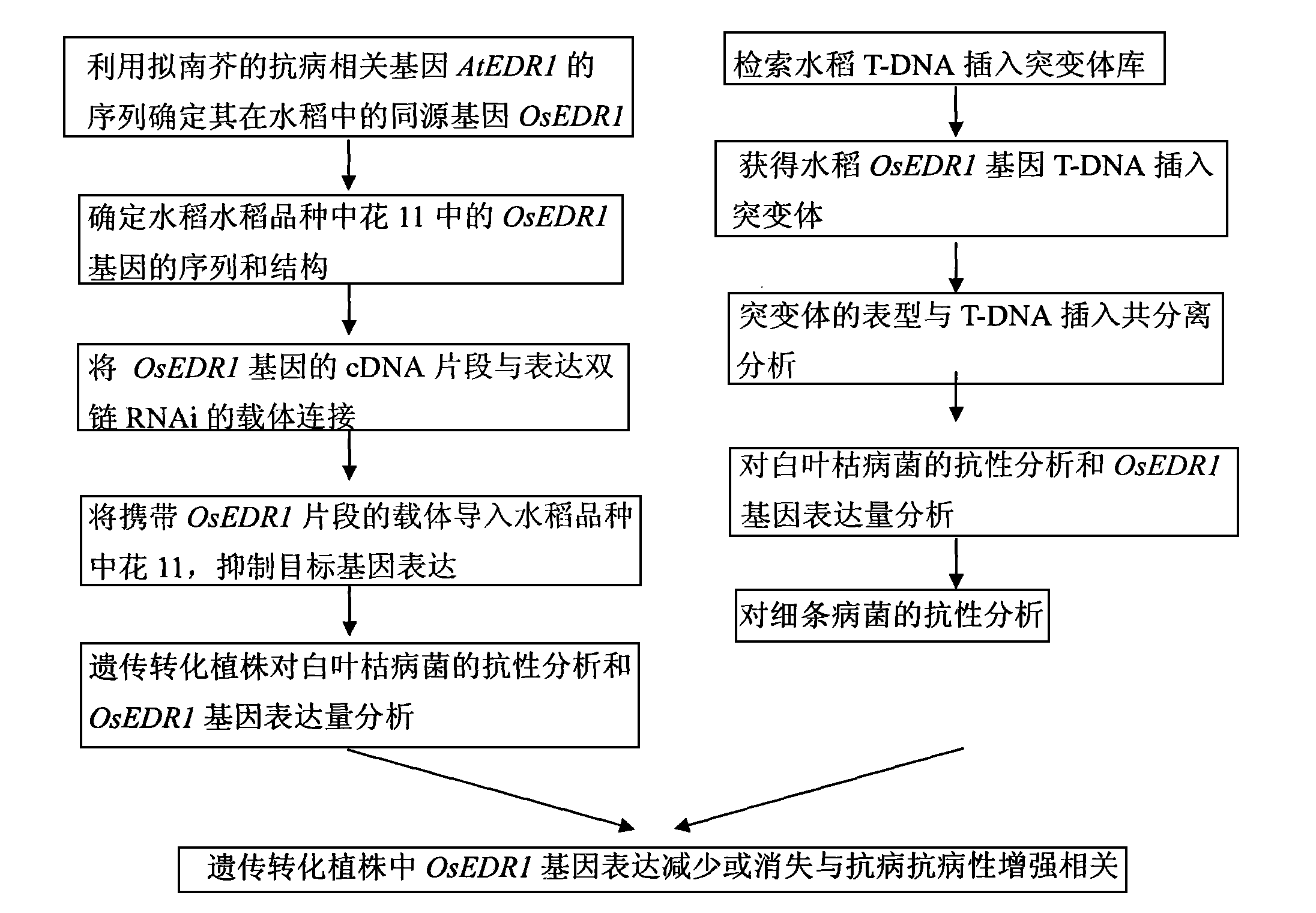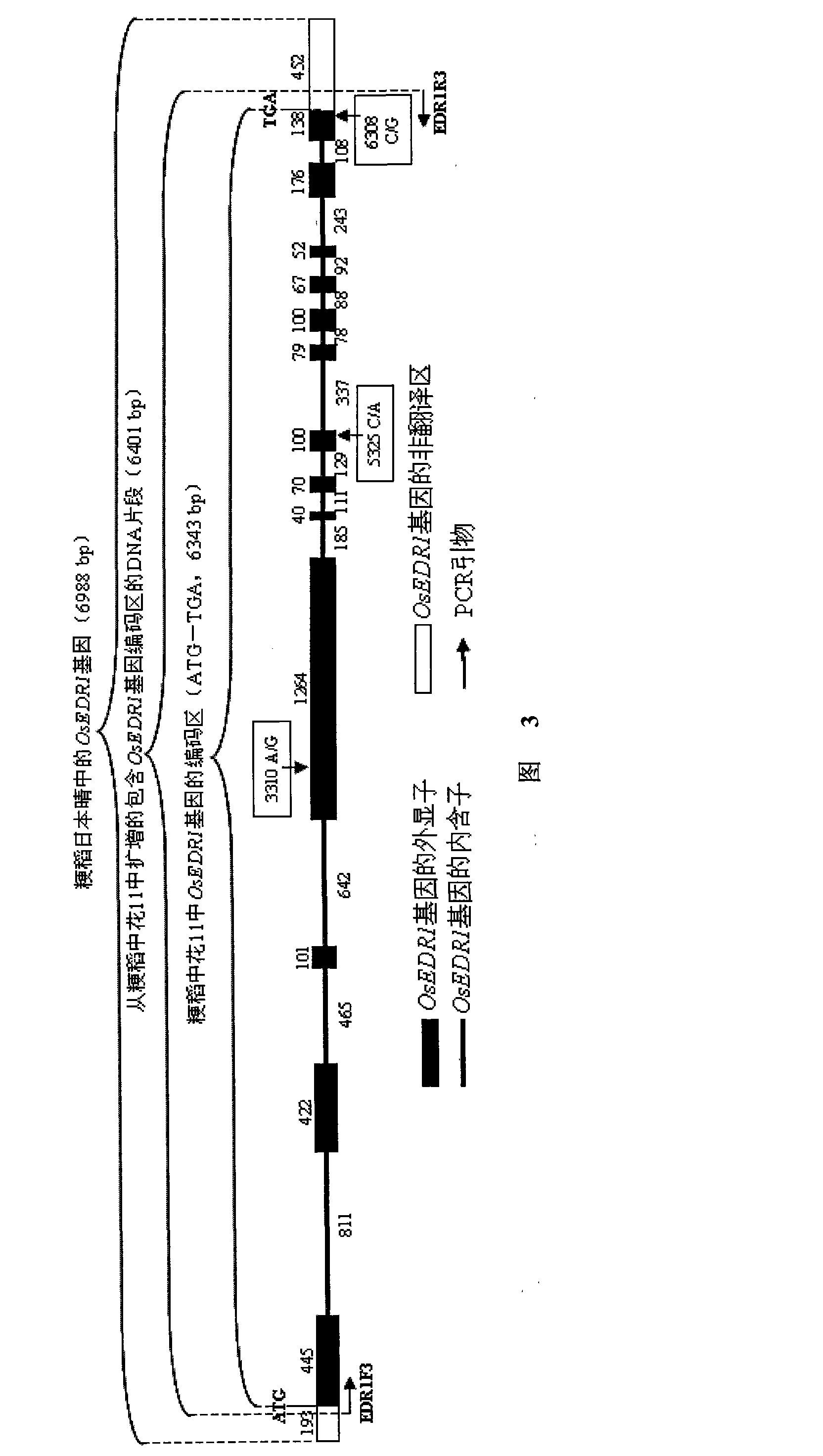Paddy disease-resistant related gene OsEDR1 and application thereof in improved paddy disease resistance
A rice and genetic technology, applied in the field of plant genetic engineering, can solve problems such as yield and quality decline, unclear, rice disease resistance phenotype changes, etc.
- Summary
- Abstract
- Description
- Claims
- Application Information
AI Technical Summary
Problems solved by technology
Method used
Image
Examples
Embodiment 1
[0023] Example 1: Analysis of the expression pattern of OsEDR1 gene in different rice varieties
[0024] The AtEDR1 gene of Arabidopsis thaliana is involved in regulating the disease resistance response of Arabidopsis thaliana. This gene encodes a mitogen-activated protein kinase kinase kinase (MAPKKK) (Frye et al., 2001). In order to analyze whether the AtEDR1 homologous gene in rice is also involved in the regulation of disease resistance response, the applicant used the BLAST analysis method (Altschul et al., 1997) to use the sequence of the AtEDR1 gene to search the rice genome sequence database [TIGR (The Institute for Genomic Research , http: / / rice.tigr.org ), it was found that the gene whose numbering site is LOC_Os03g06410 in the rice genome is the homologous gene of AtEDR1; the amino acid sequence of the protein encoded by the gene has 46.5% identity (identity) with the protein sequence of AtEDR1, and its predicted kinase region is the same as the kinase of AtEDR1 r...
Embodiment 2
[0027] Example 2: Determining the sequence and structure of the OsEDR1 gene in rice variety Zhonghua 11
[0028] 1. The sequence of the OsEDR1 gene in the rice variety Zhonghua 11
[0029] The LOC_Os03g06410 site information of the rice genome sequence database contains the cDNA sequence of the OsEDR1 gene [GenBank( http: / / www.ncbi.nlm.nih.gov ) registration number: AK111595], the cDNA sequence is 3645bp long. The rice sequence in the rice whole genome sequence database comes from the japonica rice variety Oryza sativa ssp. Japonica, and the cDNA sequence AK111595 also comes from Oryza sativa ssp. Japonica.
[0030] The applicant designed a pair of PCR primers based on the sequences on both sides of the coding region of the OsEDR1 gene in the rice variety Nipponbare: EDR1F3 (5'-AT GGTACC GTTGACGAGATGAAGAATCT-3′) (the underline represents the KpnI restriction endonuclease digestion site in the adapter for vector ligation) and EDR1R3 (5′-TAA GGTACC ACAAACTTAACAGCAACAATCATC...
Embodiment 3
[0036] Example 3: Functional verification of the OsEDR1 gene
[0037] 1. Construction of genetic transformation vector
[0038] The present invention uses RNA interference (RNA interference, RNAi) technology to verify the function of the gene by inhibiting the expression of the OsEDR1 gene in the rice variety Zhonghua 11. The main mechanism of this technical approach is to connect a partial fragment of the target gene in the form of inverted repeats to a vector capable of expressing double-stranded RNA (double strand RNA, dsRNA), and introduce the vector into plants through genetic transformation. The obtained transformed plants express a large number of dsRNAs homologous to partial fragments of the target gene. These dsRNAs rapidly form short interfering RNA (short interfering RNA, siRNA). These siRNAs are complementary to the transcripts (mRNA) of the target gene, and under the action of special enzymes in the cell, the transcripts of the target gene are degraded, thereby ...
PUM
 Login to View More
Login to View More Abstract
Description
Claims
Application Information
 Login to View More
Login to View More - R&D
- Intellectual Property
- Life Sciences
- Materials
- Tech Scout
- Unparalleled Data Quality
- Higher Quality Content
- 60% Fewer Hallucinations
Browse by: Latest US Patents, China's latest patents, Technical Efficacy Thesaurus, Application Domain, Technology Topic, Popular Technical Reports.
© 2025 PatSnap. All rights reserved.Legal|Privacy policy|Modern Slavery Act Transparency Statement|Sitemap|About US| Contact US: help@patsnap.com



